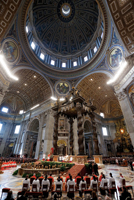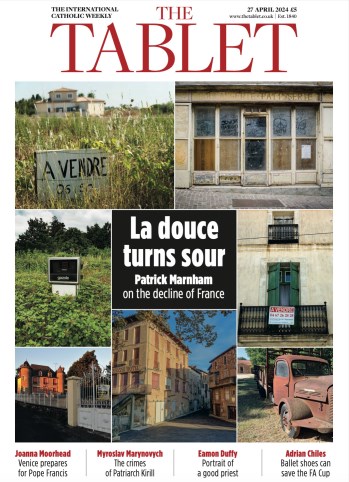The recent consistory in Rome, which saw Pope Francis create 15 new cardinal-electors from every corner of the world, marked another significant moment in his reform of the Church. But it also showed that the change he has in mind goes beyond a shake-up of the Curia
Next month, Pope Francis will mark two years since his election as Bishop of Rome. He was chosen in a 2013 conclave where several cardinals had called for a reform of the Roman Curia. It was the one thing that the cardinals, both the more traditional-minded and the moderately progressive, agreed on.
The then Archbishop of Buenos Aires – perhaps a little dour and uncharismatic, but a tough, holy, no-nonsense Jesuit outsider who had had differences of his own with curial officials – was seen as the right man for the job. Perhaps he would not set the world alight, but he would quietly put the house in order. Few imagined the whirlwind that his election was to unleash.
The cardinals’ concerns at the conclave were not new. For several years, local bishops had felt increasing frustration with the way the Church’s central bureaucracy operated. Yes, there were (and are) many dedicated, hard-working and efficient people in the Curia. But bishops who regularly visited Rome were increasingly aghast at the lethargy and petty feuding rife among many of the officials they had to work with.
Worse, many bishops felt that they were being treated like naughty schoolboys rather than vicars of Christ. The Second Vatican Council had seemed to promise a more collegial style of government in the Church. Instead, the nearly 50 years since the council ended had seen a steadily increasing centralisation and an apparent diminishing of the authority of the diocesan bishops. The feeble handling of the sex-abuse scandal, the emerging evidence of shady financial dealings and corruption, and finally the VatiLeaks affair in the closing months of Benedict XVI’s papacy added to the overwhelming pressure for reform of the Curia. A bureaucracy can get away with being bossy, rude and insensitive if it runs smoothly and gets things done. By the end of Benedict’s papacy, the Curia had become a liability and an embarrassment.
Francis was elected to initiate a reform, or some might say a “clean up”, of the Curia. Now, almost two years in, several voices are beginning to question if the process has stalled or run aground. Is serious change possible to church structures as firmly set as those in the Vatican? It’s tempting for some, perhaps in the more progressive camp, to demand instant results, while sceptics may be rushing to pronounce Francis’ efforts a failure too soon.
The Roman Curia, one of the oldest institutions in the world, is extraordinarily resistant to change. “It requires time, determination and, above all, everyone’s cooperation,” the Pope told cardinals last Thursday. That is something of an understatement. Speaking to church insiders during the consistory to discuss reform and create new cardinals last weekend, I became aware that a deep, and not simply structural, reform is coming to fruition in Francis’ papacy. And it is being likened to a revival of the spirit of the Second Vatican Council.
The Pope has already achieved several practical reforms. There has been the creation of the Secretariat for the Economy, led by Australian Cardinal George Pell, a tough administrator who gave the cardinals a detailed presentation of the Holy See’s financial position. Such an event has never happened before. A new – predominantly lay – commission, including several survivors of clerical abuse, has been set up and is working on making bishops accountable for cover-ups, while this week a Vatican-connected anti-abuse initiative announced that it was moving to new headquarters at the Pontifical Gregorian University in Rome.
On the appointment of bishops, the Pope appears to be listening to the local Church and naming pastors who are close to their people. He is also willing to be imaginative – take the appointment of Blase Cupich to Chicago – and the process of filling vacant dioceses has been speeded up. Changing the structure of the curial offices, however, is proving more difficult.
A papal advisory body, the Council of Cardinals (or C9, as it is known), was established soon after the Pope’s election, and has been meeting regularly since. It is concentrating on improving the way the Curia works, with a new apostolic constitution and proposals to slim down the organisation being finalised.
There is, however, a tension between the need to improve the efficiency of a bureaucracy widely regarded as top-heavy and the Pope’s apparent insistence that staff must not be made redundant. Some observers are hoping for an institution that is “less Italian”, but the truth is that it is not possible to get round the fact that the Church’s administration is planted in Rome.
But aside from deciding which offices and departments will go and which will stay, is there something more fundamental going on in the Vatican? The cardinals wanted a reformer, but the sort of reform that Francis wants for the Church is not what all those who elected him had in mind. It has become clear that the sort of reform Francis dreams of is not an inward-looking one, a cabinet reshuffle and a redrawing of the Vatican organogram, but one looking outwards, to the edges of the Church. We can see this in the new cardinals he created on Saturday, many from countries that have never had red hats before, including Myanmar, Panama, Cape Verde and Tonga. He has also created cardinals in non-traditional sees in Italy such as Agrigento and Ancona-Osima.
Rome last weekend was awash with colour, including flags and traditional costumes. Tonga, despite being a majority Methodist island and almost 11,000 miles away, sent a large contingent to the Eternal City. Francis’ choice of new cardinals from the furthest corners of the world is in itself a major reform. The membership of the body that will elect the next Pope is gradually coming to more closely reflect the global make-up of the Church. Equally important, however, is the way Francis has undermined clerical ambition. As particular dioceses and curial jobs no longer automatically lead to a red hat, any angling for them becomes less attractive.
Francis also wants to foster a collegial spirit among the cardinals, involving them in the governance of the universal Church. Collegiality, the concept of the Pope governing with the bishops, and synodality, are key elements to Francis’ reform.
The evidence for this is the creation of the C9 and in the increased authority and responsibility of the Synod of Bishops, which will meet again in October. But it appears that Francis wants all this to go further. In his apostolic exhortation Evangelii Gaudium he cited Vatican II on the potential of bishops’ conferences to express the “collegial spirit” in the Church. “Yet,” Francis writes, “this desire has not been fully realised, since a juridical status of episcopal conferences which would see them as subjects of specific attributions, including genuine doctrinal authority, has not yet been sufficiently elaborated.”
His papacy has already seen a change. There is a growing feeling among bishops that they have been given the authority to govern their dioceses without the Curia breathing down their necks. But Cardinal Gerhard Müller, prefect of the Congregation for the Doctrine of the Faith, has sounded dubious about devolving power to local bishops. “To foster a fair decentralisation does not mean that the episcopal conferences are given more power,” he wrote in an article on curial reform for L’Osservatore Romano ahead of the consistory, “but only that it carries on genuine responsibility which they are entitled to under the episcopal power of teaching and governing their members”.
There are feelings of both relief and tension in the Rome of Pope Francis. There is a perception that it is possible to speak a little more freely, of a little more space having been created for thoughtful discussion of awkward questions. But there is also that slight fearfulness that can be sensed in a classroom when a friendly but enigmatic new teacher enters. Is this just a temporary lull before the head teacher returns? Or, almost as frightening, is everything about to slide into chaos?
Francis appeared to allude to the opposition to his reforms in his homily during Mass with the new cardinals on Sunday, which has been described as his “mission statement”. He pointed out that Peter and Paul both faced down opposition in their day, and that Jesus caused scandal by “reaching out to save those far off, healing the wounds of the sick, restoring everyone to God’s family”. The Pope said: “Jesus is not afraid of this kind of scandal. He does not think of the closed-minded who are scandalised even by a work of healing, scandalised before any kind of openness, by any action outside of their mental and spiritual boxes.”
He called for a rejection of a “closed caste” Church that instead leaves its “four walls” to go to the furthest reaches to find the imprisoned, the persecuted, the poor, the sick, the unemployed, those in difficult circumstances and those who have lost their faith.
Changing curial structures is not, said Francis, “an end in itself”. He is setting out a new path for the Church: a “People’s Church” that puts the peripheries in the centre, that is in a constant state of mission, reaching out to the margins. If he can achieve this, then he will have done something spectacular.





 Loading ...
Loading ...
What do you think?
You can post as a subscriber user...
User Comments (3)
Thank you, Pope Francis, in your effort to create a church in which Jesus would, I suspect, be happy to be a member.
I, like so many others in the Church today, am not sure what is going on.
I trust it is not more of the "spirit of Vatican II". That has proved to be an unmitigated disaster, producing rot at the centre of the Church, with just about any graph you can think of heading for the floor.
According to the author of this article the pope is setting out a new Church that puts the peripheries at the core, which is, incidentally, where the rot is, quirte undiagnosed and unattended. The peripheries, whoever or whatever they are, may not care for it when they get there.
But one thing is sure , we will have a nice new bureaucracy to rule over the mess.
"Francis’ choice of new cardinals from the furthest corners of the world is in itself a major reform."
let us hope it will be a reform that brings "the church" closer to a spirit of love for the unorthodox, the many that live not strictly according the church's rules...
Unfortunately the history of the Anglican churches shows, that there is huge conservative/reactionary potential in remote parts of the world too.